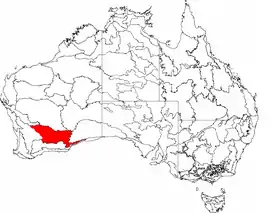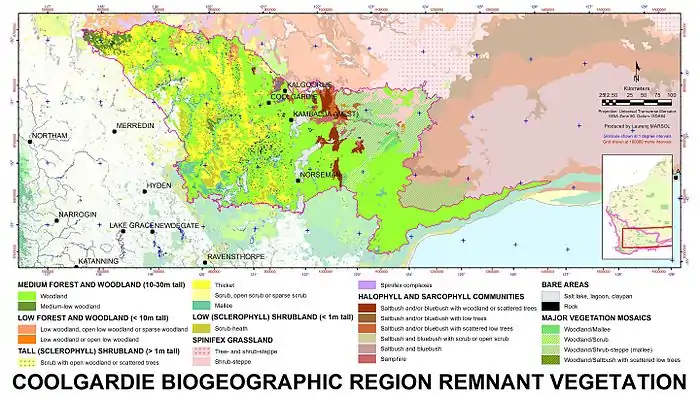Coolgardie (biogeographic region)
Coolgardie is an Australian bioregion consisting of an area of low hills and plains of infertile sandy soil in Western Australia.[1][2] It includes much of the Great Western Woodlands.

Location and description
This is a transition zone between the Mediterranean climate of Australia's south-west coast and the country's dry interior. The poor soil makes it unsuitable for agriculture but Coolgardie has been a gold and nickel mining area.
It is bounded on the north by the arid Murchison bioregion, characterized by open Mulga woodlands and steppe. The low shrublands of the arid Nullarbor Plain lie to the east.
The Mallee bioregion adjoins Coolgardie on the south. Jarrah Forest bioregion is to the west.
The Coolgardie bioregion, together with the coastal Hampton bioregion to the southeast, constitute the Coolgardie woodlands ecoregion defined by the World Wildlife Fund.[3]
Flora and fauna
The low hills are home to woodland of endemic species of eucalyptus while the sand plains are covered in scrubland. The areas nearer the west coast have more protea flowers while the drier inland is home to acacia trees and kwongan heathland.
Wildlife of the Coolgardie bioregion includes birds such as malleefowl, laughing kookaburra and barking owl, and reptiles such as the thorny devil and desert death adder. Mammals include the echidna, brushtail possum, red kangaroo, eastern wallaroo and bilby.
Vegetation

References
- Environment Australia. "Revision of the Interim Biogeographic Regionalisation for Australia (IBRA) and Development of Version 5.1 - Summary Report". Department of the Environment and Water Resources, Australian Government. Archived from the original on 5 September 2006. Retrieved 31 January 2007.
- IBRA Version 6.1 Archived September 8, 2006, at the Wayback Machine data
- "Coolgardie woodlands". Terrestrial Ecoregions. World Wildlife Fund.
Further reading
- Thackway, R and I D Cresswell (1995) An interim biogeographic regionalisation for Australia : a framework for setting priorities in the National Reserves System Cooperative Program Version 4.0 Canberra : Australian Nature Conservation Agency, Reserve Systems Unit, 1995. ISBN 0-642-21371-2